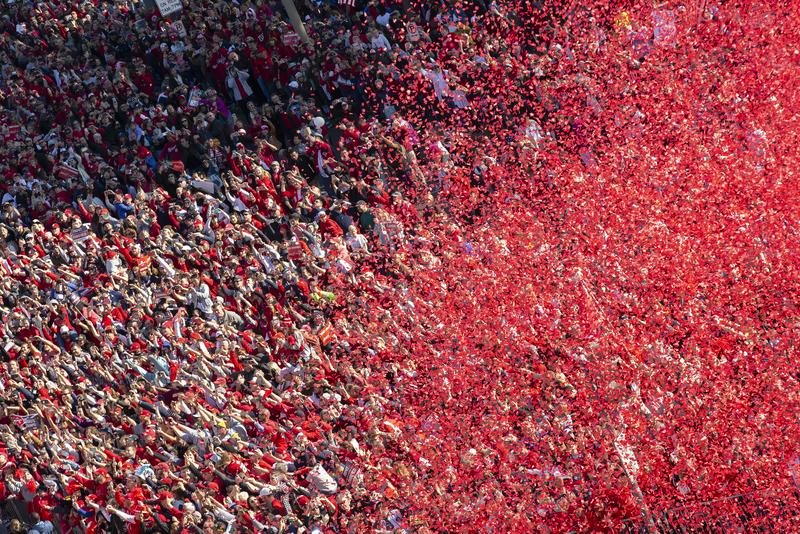Parade History: When Did We Start Doing This All The Time?
By | March 12, 2021

The word "parade" usually evokes a feeling of excitement and celebration, the deep urge to celebrate a person, idea, or event above the everyday humdrum of life. How long parades have been going on depends on how you define them, but the simplest definition is "a procession of people," usually assembling in public over a specific item or goal. The earliest known parades date all the way back to pre-history, with Spanish cave paintings depicting crowds cheering as hunters brought back their prey, but parades of today can be about anything from music and sports to war and sexual identity. So why do we march, and what are some of the most impactful parades in history?

Early Parades
For most of ancient history, parades were arranged for either religious or military purposes. In 2000 B.C.E., the Babylonians celebrated the Akitu, or the New Year, by carrying statues representing their gods through the streets and performing rituals (one of which involved beating up their own king, strangely enough). In 223 B.C.E., when consul Marcus Claudius Marcellus returned to Rome on a chariot after a decisive victory over the Gauls of Northern Italy, he was met with great fanfare from the military and citizens alike. More joyful versions of ancient parades can, of course, be seen in the ancient Olympic Games, where ceremonial dress, singing, and dancing were common elements of the athletic festival.
One of the most enduring mass celebrations on Earth is the Chinese Lunar New Year, which is still observed by over 1.5 billion people annually. The earliest evidence of the Chinese calendar is thought to be from around 1400 B.C.E., and over the following centuries, more and more traditions rose to mark the occasion. Animal sacrifices and home cleaning were some of the earliest, but the most famous iconography—fireworks, dumplings, the dragon dance—actually didn't pop up until the time of the Tang Dynasty of the fifth century C.E. Fun fact: The biggest lunar festival outside of China takes place in San Francisco, California, thanks mostly to the large Chinese-American population whose ancestors immigrated during the Gold Rush of 1848.

Parades In America
In the United States, parades have taken on many forms over the centuries. George Washington often used parades and fanfare to boost morale during the Revolutionary War and was himself the focus of many parades during his presidency, though he also worried about "the reverse of the scene" if these huge events turned into protests. Military parades have long been used in America to either boost morale or celebrate the end of a harrowing conflict, such as the Grand Review of the Armies, where crowds sang and cheered on marching Union troops following the end of the Civil War.
Perhaps no celebration was more jubilant, though, than the various impromptu mass celebrations that broke out on August 14, 1945, A.K.A. V-J ("victory over Japan") Day, which marked the official end of World War II. New York City's Time Square witnessed the largest crowd in the history of its existence as two million people packed shoulder to shoulder to cheer and maybe even kiss a total stranger, as seen in the iconic "kissing sailor" photo snapped by Alfred Eisenstaedt.

Pride Parades
Washington certainly got one thing right: One of the most popular parades in the United States today, the nationwide Pride Day parade, actually does have its roots in protest. During the 1960s, raids on businesses frequented by those of the L.G.B.T. community were common, and on June 28, 1969, the police raided New York City's Stonewall Inn, where patrons were met with physical violence and invasive "checks" of their private body parts. The ensuing riot lasted six days.
The Stonewall Uprising is often viewed as a milestone of the L.G.B.T. rights movement, so on the anniversary of the event, local L.G.B.T. communities held pride marches in cities like Chicago, San Francisco, and New York City. While initially solemn events, the marches took on a more celebratory, parade-like atmosphere in the '80s that largely remains today. Floats, music, and dancing are standard elements of Pride Day parades in major cities with large L.G.B.T. populations, and in cities like Los Angeles, the party can last for several days. Although Pride Day's origins are squarely American, countries across the globe from Japan to Argentina celebrate June as Pride Month.

The Parade To End All Parades
Probably the most infamous parade in the United States, however, is the beloved Mardi Gras parade that graces the streets of New Orleans, Louisiana every year. French for "Fat Tuesday," Mardi Gras has its roots in an ancient tradition of pagan fertility rituals, most likely in relation to Saturnalia, that morphed into a Christian festival, a fate that befell many pagan holidays during the spread of Catholicism over Europe in the Middle Ages.
In preparation for the fasting often practiced during Lent, many gorged themselves on all of the most delicious foods the day before Ash Wednesday, hence the name "Fat Tuesday." Over the years, however, the religious underpinnings of the festival largely faded in favor of costumes, floats, music, and dancing. Today, the holiday is largely known for the wild behavior of its celebrants, including drinking to excess and flashing their breasts in exchange for colorful beads, presumably to the utter disapproval of devout Catholics. This style of pre-Lent partying is also popular in historically Catholic nations across the globe, better known by the name of Carnival.

